Hanyangling Mausoleum Museum
The Han Yang Ling (simplified Chinese: 汉阳陵; traditional Chinese: 漢陽陵; pinyin: Hàn Yáng líng), or the Yang Mausoleum of Han, is the mausoleum of Emperor Jing, the sixth emperor of the Western Han Dynasty and his Empress Wang. The mausoleum complex is located in the Weicheng district of the City of Xianyang, Shaanxi Province, on the northern bank of the Wei River and about 20 km to the north of the city center of the provincial capital of Xi’an.
The Mausoleum of Emperor Jingdi (Hanyang Tomb), is a joint mausoleum of Liu Qi (188 -141 BC), the fourth emperor of the Western Han Dynasty, and his wife Empress Wang. It is located at Zhanjiawan Village, about 20 kilometers north of Xian City, where Emperor Jingdi of Western Han Dynasty was buried.
During the 17-year reign of Emperor Jingdi, he developed a peaceful relationship with the Huns (nomads to the north of China) through intermarriage, and reduced the burden of tax, corvee and penalty, by which way Han economy developed rapidly after the turmoil at the end of Qin Dynasty. So he is remembered as a capable emperor in Chinese history, together with his father Emperor Wendi, opened a golden era of harmony in the early feudal society, which was later regarded as “the Great Reign of Wen and Jing”.
The total area of the mausoleum is 20 square meters and the construction time is as long as 28 years from 153 BC to 126 BC. The entire complex is designed in line with the imperial state powers and their predominant hierarchic ranks, taking the Emperor’s graveyard as the very center, scattered around it are burial pits, archaeological exhibitions, criminal graveyard and some satellite tombs.
The Mausoleum of Emperor Jingdi was excavated in 1972 which was the beginning of the excavation of Hanyang Mausoleum. In 2007, the underground Protection Hall covering ten burial pits east of the emperor’s tomb mound with an area of 8000 square meters, was opened to public. It has been modernized with heated glass wall and tunnel to separate the relics and visitors into two areas of different temperature and humidity aimed to protect and maintain the relics on a large scale while allowing visitors to view the relics at different angles within a short distance in the mysterious environment. A large amount of colored pottery figurines and other items are displayed here.
WANGDA SHOWCASES designed,supplied and installed all the customized museum grade display cases|museum showcase|museum display cabinets|vitrines for the mausoleum museum of the renowned Emperor over 2000 years ago.
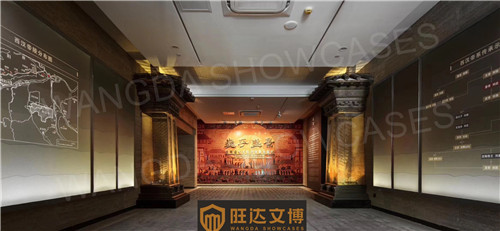
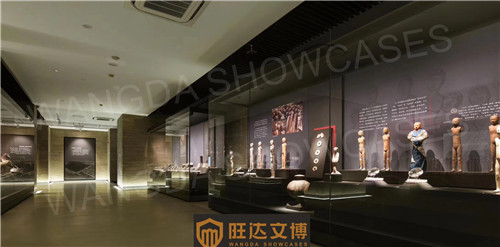
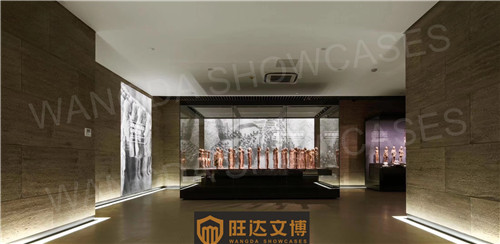
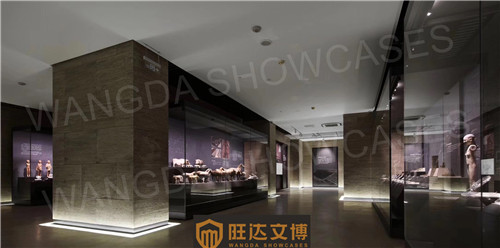

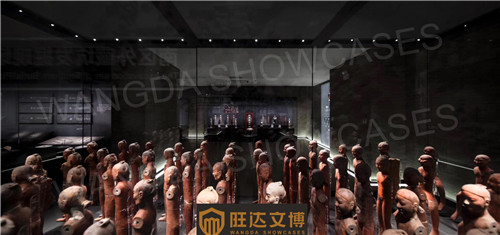
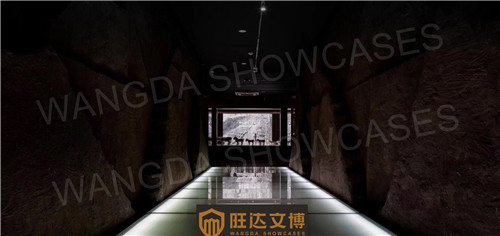
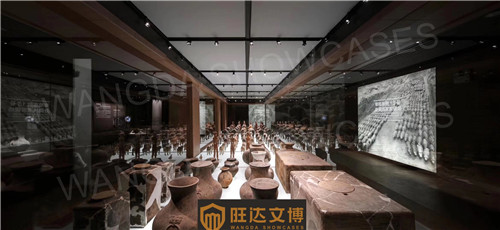
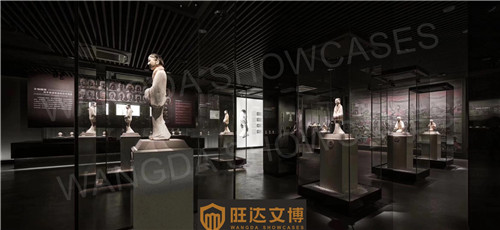
The Han Yang Ling (simplified Chinese: 汉阳陵; traditional Chinese: 漢陽陵; pinyin: Hàn Yáng líng), or the Yang Mausoleum of Han, is the mausoleum of Emperor Jing, the sixth emperor of the Western Han Dynasty and his Empress Wang. The mausoleum complex is located in the Weicheng district of the City of Xianyang, Shaanxi Province, on the northern bank of the Wei River and about 20 km to the north of the city center of the provincial capital of Xi’an.
The Mausoleum of Emperor Jingdi (Hanyang Tomb), is a joint mausoleum of Liu Qi (188 -141 BC), the fourth emperor of the Western Han Dynasty, and his wife Empress Wang. It is located at Zhanjiawan Village, about 20 kilometers north of Xian City, where Emperor Jingdi of Western Han Dynasty was buried.
During the 17-year reign of Emperor Jingdi, he developed a peaceful relationship with the Huns (nomads to the north of China) through intermarriage, and reduced the burden of tax, corvee and penalty, by which way Han economy developed rapidly after the turmoil at the end of Qin Dynasty. So he is remembered as a capable emperor in Chinese history, together with his father Emperor Wendi, opened a golden era of harmony in the early feudal society, which was later regarded as “the Great Reign of Wen and Jing”.
The total area of the mausoleum is 20 square meters and the construction time is as long as 28 years from 153 BC to 126 BC. The entire complex is designed in line with the imperial state powers and their predominant hierarchic ranks, taking the Emperor’s graveyard as the very center, scattered around it are burial pits, archaeological exhibitions, criminal graveyard and some satellite tombs.
The Mausoleum of Emperor Jingdi was excavated in 1972 which was the beginning of the excavation of Hanyang Mausoleum. In 2007, the underground Protection Hall covering ten burial pits east of the emperor’s tomb mound with an area of 8000 square meters, was opened to public. It has been modernized with heated glass wall and tunnel to separate the relics and visitors into two areas of different temperature and humidity aimed to protect and maintain the relics on a large scale while allowing visitors to view the relics at different angles within a short distance in the mysterious environment. A large amount of colored pottery figurines and other items are displayed here.
WANGDA SHOWCASES designed,supplied and installed all the customized museum grade display cases|museum showcase|museum display cabinets|vitrines for the mausoleum museum of the renowned Emperor over 2000 years ago.









